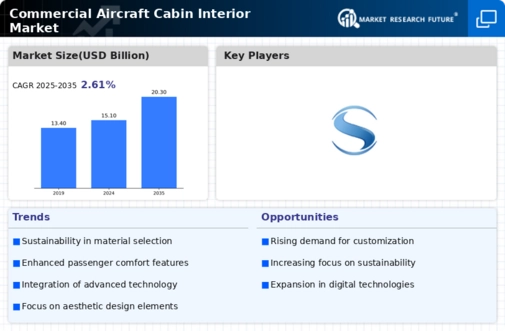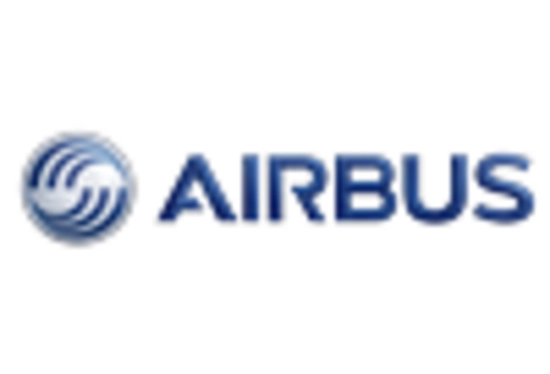-
Executive Summary
-
Market Introduction
-
Definition 20
-
Scope Of The Study 20
-
List Of Assumptions 21
-
Market Structure 21
-
Research Methodology
-
Research Process 23
-
Primary Research 24
-
Secondary Research 25
-
Market Size Estimation 25
-
Forecast Model 26
-
Market Dynamics
-
Introduction 28
-
Drivers 29
- Increase In Passenger Traffic 29
- Rising Adoption Of IFEC Systems 30
- Retrofit Of Existing Aircraft 30
- Drivers Impact Analysis 31
-
Restraints 31
- Delays In Aircraft Deliveries 31
- Decreasing Profitability Of Airlines In Developing Regions 32
- Restraints Impact Analysis 32
-
Opportunities 32
- Increasing Preference For Customization Of Aircraft Cabins 32
-
Market Factor Analysis
-
Supply Chain Analysis 34
- Design And Development 34
- Raw Material/Component Supply 34
- Manufacturing And Assembly 34
- Distribution 35
- End Users 35
- Aftermarket 35
-
Porter’s Five Forces Model 35
- Threat Of New Entrants 35
- Bargaining Power Of Suppliers 36
- Bargaining Power Of Buyers 36
- Threat Of Substitutes 36
- Rivalry 36
-
Technological Trends 37
- In-Flight Connectivity And Personalized Lighting Systems In Aircraft Cabin Interior 37
- Advancements In Aircraft Cabin Interior Components And Materials 37
- Lavatories 37
- Smart Seats 37
- Anti-Bacterial Seats And Smart Windows 37
- Material 37
- Digital Aircraft Cabin 37
-
Regulatory Landscape 38
-
Patent Analysis 39
- List Of Patents 39
-
Global Commercial Aircraft Cabin Interior Market, By Product Type
-
Overview 44
- Seating 45
- In-Flight Entertainment 46
- Lighting 47
- Galley 48
- Lavatory 49
- Windows 50
- Others 51
-
Global Commercial Aircraft Cabin Interior Market, By Aircraft Type
-
Overview 53
- Narrow-Body Aircraft 54
- Wide-Body Aircraft 55
-
Global Commercial Aircraft Cabin Interior Market, By Fit
-
Overview 57
- Line-Fit 58
- Retrofit 59
-
Global Commercial Aircraft Cabin Interior Market, By Region
-
Overview 61
-
North America 62
- US 64
- Canada 65
-
Europe 67
- France 69
- UK 71
- Germany 72
- Italy 74
- Rest Of Europe 76
-
Asia-Pacific 78
- China 80
- India 82
- Japan 84
- Australia 86
- Rest Of Asia-Pacific 88
-
Latin America 90
- Brazil 92
- Mexico 93
- Rest Of Latin America 95
-
Middle East & Africa 97
- UAE 99
- Saudi Arabia 100
- South Africa 101
- Rest Of Middle East & Africa 103
-
Competitive Landscape
-
Competitive Scenario 106
-
Market Share Analysis 106
-
Mergers & Acquisitions 107
-
Competitor Benchmarking 108
-
Company Profiles
-
Rockwell Collins 110
- Company Overview 110
- Financial Overview 110
- Products/Services Offered 111
- Key Developments 113
- SWOT Analysis 114
- Key Strategies 114
-
RECARO Aircraft Seating GmbH & Co. KG 115
- Company Overview 115
- Financial Overview 115
- Products/Services Offered 115
- Key Developments 116
- SWOT Analysis 116
- Key Strategies 116
-
Zodiac Aerospace 117
- Company Overview 117
- Financial Overview 117
- Products/Services Offered 118
- Key Developments 120
- SWOT Analysis 120
- Key Strategies 121
-
Panasonic Avionics Corporation 122
- Company Overview 122
- Financial Overview 122
- Products/Services Offered 123
- Key Developments 124
- SWOT Analysis 125
- Key Strategies 125
-
Diehl Stiftung & Co. KG 126
- Company Overview 126
- Financial Overview 126
- Products/Services Offered 127
- Key Developments 128
- SWOT Analysis 128
- Key Strategies 129
-
Cobham Plc 130
- Company Overview 130
- Financial Overview 130
- Products/Services Offered 131
- Key Developments 131
- SWOT Analysis 132
- Key Strategies 132
-
JAMCO Corporation 133
- Company Overview 133
- Financial Overview 133
- Products/Services Offered 134
- Key Developments 134
- SWOT Analysis 135
- Key Strategies 135
-
Astronics Corporation 136
- Company Overview 136
- Financial Overview 136
- Products/Services Offered 137
- Key Developments 138
- SWOT Analysis 139
- Key Strategies 139
-
United Technologies Corporation 140
- Company Overview 140
- Financial Overview 140
- Products/Services Offered 141
- Key Developments 142
- SWOT Analysis 142
- Key Strategies 142
-
Honeywell International Inc. 143
- Company Overview 143
- Financial Overview 143
- Products/Services Offered 144
- Key Developments 145
- SWOT Analysis 145
- Key Strategies 145
-
Appendix
-
List Of References 147
-
List Of Tables
-
MARKET SYNOPSIS 18
-
LIST OF ASSUMPTIONS 21
-
GLOBAL COMMERCIAL AIRCRAFT CABIN INTERIOR MARKET: REGULATORY LANDSCAPE 38
-
MAJOR GRANTED PATENTS ON AIRCRAFT CABIN INTERIOR 39
-
GLOBAL COMMERCIAL AIRCRAFT CABIN INTERIOR MARKET, BY PRODUCT TYPE, 2024-2032 (USD MILLION) 44
-
SEATING: COMMERCIAL AIRCRAFT CABIN INTERIOR MARKET, BY REGION, 2024-2032 (USD MILLION) 45
-
IN-FLIGHT ENTERTAINMENT: COMMERCIAL AIRCRAFT CABIN INTERIOR MARKET, BY REGION, 2024-2032 (USD MILLION) 46
-
LIGHTING: COMMERCIAL AIRCRAFT CABIN INTERIOR MARKET, BY REGION, 2024-2032 (USD MILLION) 47
-
GALLEY: COMMERCIAL AIRCRAFT CABIN INTERIOR MARKET, BY REGION, 2024-2032 (USD MILLION) 48
-
LAVATORY: COMMERCIAL AIRCRAFT CABIN INTERIOR MARKET, BY REGION, 2024-2032 (USD MILLION) 49
-
WINDOWS: COMMERCIAL AIRCRAFT CABIN INTERIOR MARKET, BY REGION, 2024-2032 (USD MILLION) 50
-
OTHERS: COMMERCIAL AIRCRAFT CABIN INTERIOR MARKET, BY REGION, 2024-2032 (USD MILLION) 51
-
GLOBAL COMMERCIAL AIRCRAFT CABIN INTERIOR MARKET, BY AIRCRAFT TYPE, 2024-2032 (USD MILLION) 53
-
NARROW-BODY AIRCRAFT: COMMERCIAL AIRCRAFT CABIN INTERIOR MARKET, BY REGION, 2024-2032 (USD MILLION) 54
-
WIDE-BODY AIRCRAFT: COMMERCIAL AIRCRAFT CABIN INTERIOR MARKET, BY REGION, 2024-2032 (USD MILLION) 55
-
GLOBAL COMMERCIAL AIRCRAFT CABIN INTERIOR MARKET, BY FIT, 2024-2032 (USD MILLION) 57
-
LINE-FIT: COMMERCIAL AIRCRAFT CABIN INTERIOR MARKET, BY REGION, 2024-2032 (USD MILLION) 58
-
RETROFIT: COMMERCIAL AIRCRAFT CABIN INTERIOR MARKET, BY REGION, 2024-2032 (USD MILLION) 59
-
GLOBAL COMMERCIAL AIRCRAFT CABIN INTERIOR MARKET, BY REGION, 2024-2032 (USD MILLION) 61
-
NORTH AMERICA: COMMERCIAL AIRCRAFT CABIN INTERIOR MARKET, BY PRODUCT TYPE, 2024-2032 (USD MILLION) 62
-
NORTH AMERICA: COMMERCIAL AIRCRAFT CABIN INTERIOR MARKET, BY AIRCRAFT TYPE, 2024-2032 (USD MILLION) 63
-
NORTH AMERICA: COMMERCIAL AIRCRAFT CABIN INTERIOR MARKET, BY FIT, 2024-2032 (USD MILLION) 63
-
NORTH AMERICA: COMMERCIAL AIRCRAFT CABIN INTERIOR MARKET, BY COUNTRY, 2024-2032 (USD MILLION) 63
-
US: COMMERCIAL AIRCRAFT CABIN INTERIOR MARKET, BY PRODUCT TYPE, 2024-2032 (USD MILLION) 64
-
US: COMMERCIAL AIRCRAFT CABIN INTERIOR MARKET, BY AIRCRAFT TYPE, 2024-2032 (USD MILLION) 64
-
US: COMMERCIAL AIRCRAFT CABIN INTERIOR MARKET, BY FIT, 2024-2032 (USD MILLION) 65
-
CANADA: COMMERCIAL AIRCRAFT CABIN INTERIOR MARKET, BY PRODUCT TYPE, 2024-2032 (USD MILLION) 65
-
CANADA: COMMERCIAL AIRCRAFT CABIN INTERIOR MARKET, BY AIRCRAFT TYPE, 2024-2032 (USD MILLION) 65
-
CANADA: COMMERCIAL AIRCRAFT CABIN INTERIOR MARKET, BY FIT, 2024-2032 (USD MILLION) 66
-
EUROPE: COMMERCIAL AIRCRAFT CABIN INTERIOR MARKET, BY PRODUCT TYPE, 2024-2032 (USD MILLION) 67
-
EUROPE: COMMERCIAL AIRCRAFT CABIN INTERIOR MARKET, BY AIRCRAFT TYPE, 2024-2032 (USD MILLION) 68
-
EUROPE: COMMERCIAL AIRCRAFT CABIN INTERIOR MARKET, BY FIT, 2024-2032 (USD MILLION) 68
-
EUROPE: COMMERCIAL AIRCRAFT CABIN INTERIOR MARKET, BY COUNTRY, 2024-2032 (USD MILLION) 69
-
FRANCE: COMMERCIAL AIRCRAFT CABIN INTERIOR MARKET, BY PRODUCT TYPE, 2024-2032 (USD MILLION) 69
-
FRANCE: COMMERCIAL AIRCRAFT CABIN INTERIOR MARKET, BY AIRCRAFT TYPE, 2024-2032 (USD MILLION) 70
-
FRANCE: COMMERCIAL AIRCRAFT CABIN INTERIOR MARKET, BY FIT, 2024-2032 (USD MILLION) 70
-
UK: COMMERCIAL AIRCRAFT CABIN INTERIOR MARKET, BY PRODUCT TYPE, 2024-2032 (USD MILLION) 71
-
UK: COMMERCIAL AIRCRAFT CABIN INTERIOR MARKET, BY AIRCRAFT TYPE, 2024-2032 (USD MILLION) 71
-
UK: COMMERCIAL AIRCRAFT CABIN INTERIOR MARKET, BY FIT, 2024-2032 (USD MILLION) 72
-
GERMANY: COMMERCIAL AIRCRAFT CABIN INTERIOR MARKET, BY PRODUCT TYPE, 2024-2032 (USD MILLION) 72
-
GERMANY: COMMERCIAL AIRCRAFT CABIN INTERIOR MARKET, BY AIRCRAFT TYPE, 2024-2032 (USD MILLION) 73
-
GERMANY: COMMERCIAL AIRCRAFT CABIN INTERIOR MARKET, BY FIT, 2024-2032 (USD MILLION) 73
-
ITALY: COMMERCIAL AIRCRAFT CABIN INTERIOR MARKET, BY PRODUCT TYPE, 2024-2032 (USD MILLION) 74
-
ITALY: COMMERCIAL AIRCRAFT CABIN INTERIOR MARKET, BY AIRCRAFT TYPE, 2024-2032 (USD MILLION) 75
-
ITALY: COMMERCIAL AIRCRAFT CABIN INTERIOR MARKET, BY FIT, 2024-2032 (USD MILLION) 75
-
REST OF EUROPE: COMMERCIAL AIRCRAFT CABIN INTERIOR MARKET, BY PRODUCT TYPE, 2024-2032 (USD MILLION) 76
-
REST OF EUROPE: COMMERCIAL AIRCRAFT CABIN INTERIOR MARKET, BY AIRCRAFT TYPE, 2024-2032 (USD MILLION) 76
-
REST OF EUROPE: COMMERCIAL AIRCRAFT CABIN INTERIOR MARKET, BY FIT, 2024-2032 (USD MILLION) 76
-
ASIA-PACIFIC: COMMERCIAL AIRCRAFT CABIN INTERIOR MARKET, BY PRODUCT TYPE, 2024-2032 (USD MILLION) 78
-
ASIA-PACIFIC: COMMERCIAL AIRCRAFT CABIN INTERIOR MARKET, BY AIRCRAFT TYPE, 2024-2032 (USD MILLION) 78
-
ASIA-PACIFIC: COMMERCIAL AIRCRAFT CABIN INTERIOR MARKET, BY FIT, 2024-2032 (USD MILLION) 79
-
ASIA-PACIFIC: COMMERCIAL AIRCRAFT CABIN INTERIOR MARKET, BY COUNTRY, 2024-2032 (USD MILLION) 79
-
CHINA: COMMERCIAL AIRCRAFT CABIN INTERIOR MARKET, BY PRODUCT TYPE, 2024-2032 (USD MILLION) 80
-
CHINA: COMMERCIAL AIRCRAFT CABIN INTERIOR MARKET, BY AIRCRAFT TYPE, 2024-2032 (USD MILLION) 81
-
CHINA: COMMERCIAL AIRCRAFT CABIN INTERIOR MARKET, BY FIT, 2024-2032 (USD MILLION) 81
-
INDIA: COMMERCIAL AIRCRAFT CABIN INTERIOR MARKET, BY PRODUCT TYPE, 2024-2032 (USD MILLION) 82
-
INDIA: COMMERCIAL AIRCRAFT CABIN INTERIOR MARKET, BY AIRCRAFT TYPE, 2024-2032 (USD MILLION) 83
-
INDIA: COMMERCIAL AIRCRAFT CABIN INTERIOR MARKET, BY FIT, 2024-2032 (USD MILLION) 83
-
JAPAN: COMMERCIAL AIRCRAFT CABIN INTERIOR MARKET, BY PRODUCT TYPE, 2024-2032 (USD MILLION) 84
-
JAPAN: COMMERCIAL AIRCRAFT CABIN INTERIOR MARKET, BY AIRCRAFT TYPE, 2024-2032 (USD MILLION) 85
-
JAPAN: COMMERCIAL AIRCRAFT CABIN INTERIOR MARKET, BY FIT, 2024-2032 (USD MILLION) 85
-
AUSTRALIA: COMMERCIAL AIRCRAFT CABIN INTERIOR MARKET, BY PRODUCT TYPE, 2024-2032 (USD MILLION) 86
-
AUSTRALIA: COMMERCIAL AIRCRAFT CABIN INTERIOR MARKET, BY AIRCRAFT TYPE, 2024-2032 (USD MILLION) 87
-
AUSTRALIA: COMMERCIAL AIRCRAFT CABIN INTERIOR MARKET, BY FIT, 2024-2032 (USD MILLION) 87
-
REST OF ASIA-PACIFIC: COMMERCIAL AIRCRAFT CABIN INTERIOR MARKET, BY PRODUCT TYPE, 2024-2032 (USD MILLION) 88
-
REST OF ASIA-PACIFIC: COMMERCIAL AIRCRAFT CABIN INTERIOR MARKET, BY AIRCRAFT TYPE, 2024-2032 (USD MILLION) 88
-
REST OF ASIA-PACIFIC: COMMERCIAL AIRCRAFT CABIN INTERIOR MARKET, BY FIT, 2024-2032 (USD MILLION) 89
-
LATIN AMERICA: COMMERCIAL AIRCRAFT CABIN INTERIOR MARKET, BY PRODUCT TYPE, 2024-2032 (USD MILLION) 90
-
LATIN AMERICA: COMMERCIAL AIRCRAFT CABIN INTERIOR MARKET, BY AIRCRAFT TYPE, 2024-2032 (USD MILLION) 91
-
LATIN AMERICA: COMMERCIAL AIRCRAFT CABIN INTERIOR MARKET, BY FIT, 2024-2032 (USD MILLION) 91
-
LATIN AMERICA: COMMERCIAL AIRCRAFT CABIN INTERIOR MARKET, BY COUNTRY, 2024-2032 (USD MILLION) 91
-
BRAZIL: COMMERCIAL AIRCRAFT CABIN INTERIOR MARKET, BY PRODUCT TYPE, 2024-2032 (USD MILLION) 92
-
BRAZIL: COMMERCIAL AIRCRAFT CABIN INTERIOR MARKET, BY AIRCRAFT TYPE, 2024-2032 (USD MILLION) 92
-
BRAZIL: COMMERCIAL AIRCRAFT CABIN INTERIOR MARKET, BY FIT, 2024-2032 (USD MILLION) 93
-
MEXICO: COMMERCIAL AIRCRAFT CABIN INTERIOR MARKET, BY PRODUCT TYPE, 2024-2032 (USD MILLION) 93
-
MEXICO: COMMERCIAL AIRCRAFT CABIN INTERIOR MARKET, BY AIRCRAFT TYPE, 2024-2032 (USD MILLION) 94
-
MEXICO: COMMERCIAL AIRCRAFT CABIN INTERIOR MARKET, BY FIT, 2024-2032 (USD MILLION) 94
-
REST OF LATIN AMERICA: COMMERCIAL AIRCRAFT CABIN INTERIOR MARKET, BY PRODUCT TYPE, 2024-2032 (USD MILLION) 95
-
REST OF LATIN AMERICA: COMMERCIAL AIRCRAFT CABIN INTERIOR MARKET, BY AIRCRAFT TYPE, 2024-2032 (USD MILLION) 96
-
REST OF LATIN AMERICA: COMMERCIAL AIRCRAFT CABIN INTERIOR MARKET, BY FIT, 2024-2032 (USD MILLION) 96
-
MIDDLE EAST & AFRICA: COMMERCIAL AIRCRAFT CABIN INTERIOR MARKET, BY PRODUCT TYPE, 2024-2032 (USD MILLION) 97
-
MIDDLE EAST & AFRICA: COMMERCIAL AIRCRAFT CABIN INTERIOR MARKET, BY AIRCRAFT TYPE, 2024-2032 (USD MILLION) 98
-
MIDDLE EAST & AFRICA: COMMERCIAL AIRCRAFT CABIN INTERIOR MARKET, BY FIT, 2024-2032 (USD MILLION) 98
-
MIDDLE EAST & AFRICA: COMMERCIAL AIRCRAFT CABIN INTERIOR MARKET, BY COUNTRY, 2024-2032 (USD MILLION) 98
-
UAE: COMMERCIAL AIRCRAFT CABIN INTERIOR MARKET, BY PRODUCT TYPE, 2024-2032 (USD MILLION) 99
-
UAE: COMMERCIAL AIRCRAFT CABIN INTERIOR MARKET, BY AIRCRAFT TYPE, 2024-2032 (USD MILLION) 99
-
UAE: COMMERCIAL AIRCRAFT CABIN INTERIOR MARKET, BY FIT, 2024-2032 (USD MILLION) 100
-
SAUDI ARABIA: COMMERCIAL AIRCRAFT CABIN INTERIOR MARKET, BY PRODUCT TYPE, 2024-2032 (USD MILLION) 100
-
SAUDI ARABIA: COMMERCIAL AIRCRAFT CABIN INTERIOR MARKET, BY AIRCRAFT TYPE, 2024-2032 (USD MILLION) 101
-
SAUDI ARABIA: COMMERCIAL AIRCRAFT CABIN INTERIOR MARKET, BY FIT, 2024-2032 (USD MILLION) 101
-
SOUTH AFRICA: COMMERCIAL AIRCRAFT CABIN INTERIOR MARKET, BY PRODUCT TYPE, 2024-2032 (USD MILLION) 102
-
SOUTH AFRICA: COMMERCIAL AIRCRAFT CABIN INTERIOR MARKET, BY AIRCRAFT TYPE, 2024-2032 (USD MILLION) 102
-
SOUTH AFRICA: COMMERCIAL AIRCRAFT CABIN INTERIOR MARKET, BY FIT, 2024-2032 (USD MILLION) 103
-
REST OF MIDDLE EAST & AFRICA: COMMERCIAL AIRCRAFT CABIN INTERIOR MARKET, BY PRODUCT TYPE, 2024-2032 (USD MILLION) 103
-
REST OF MIDDLE EAST & AFRICA: COMMERCIAL AIRCRAFT CABIN INTERIOR MARKET, BY AIRCRAFT TYPE, 2024-2032 (USD MILLION) 104
-
REST OF MIDDLE EAST & AFRICA: COMMERCIAL AIRCRAFT CABIN INTERIOR MARKET, BY FIT, 2024-2032 (USD MILLION) 104
-
GLOBAL COMMERCIAL AIRCRAFT CABIN INTERIOR MARKET: MERGERS & ACQUISITIONS 107
-
BENCHMARKING OF THE MAJOR COMPETITORS 108
-
ROCKWELL COLLINS: PRODUCT/SERVICES OFFERED 111
-
ROCKWELL COLLINS: KEY DEVELOPMENTS 113
-
RECARO AIRCRAFT SEATING GMBH & CO. KG: PRODUCTS/SERVICES OFFERED 115
-
RECARO AIRCRAFT SEATING GMBH & CO. KG: KEY DEVELOPMENTS 116
-
ZODIAC AEROSPACE: PRODUCT/SERVICES OFFERED 118
-
ZODIAC AEROSPACE: KEY DEVELOPMENTS 120
-
PANASONIC AVIONICS CORPORATION: PRODUCT/SERVICES OFFERED 123
-
PANASONIC AVIONICS CORPORATION: KEY DEVELOPMENTS 124
-
DIEHL STIFTUNG & CO. KG: PRODUCT/SERVICES OFFERED 127
-
DIEHL STIFTUNG & CO. KG: KEY DEVELOPMENTS 128
-
COBHAM PLC: PRODUCTS/SERVICES OFFERED 131
-
JAMCO CORPORATION.: PRODUCTS/SERVICES OFFERED 134
-
JAMCO CORPORATION: KEY DEVELOPMENTS 134
-
ASTRONICS CORPORATION: PRODUCTS/SERVICES OFFERED 137
-
ASTRONICS CORPORATION: KEY DEVELOPMENTS 138
-
UNITED TECHNOLOGIES: PRODUCTS/SERVICES OFFERED 141
-
UNITED TECHNOLOGIES: KEY DEVELOPMENTS 142
-
HONEYWELL INTERNATIONAL INC.: PRODUCTS/SERVICES OFFERED 144
-
HONEYWELL INTERNATIONAL INC.: KEY DEVELOPMENTS 145
-
List Of Figures
-
GLOBAL COMMERCIAL AIRCRAFT CABIN INTERIOR MARKET: MARKET STRUCTURE 21
-
RESEARCH PROCESS OF MRFR 23
-
TOP-DOWN & BOTTOM-UP APPROACHES 26
-
DRO ANALYSIS OF GLOBAL COMMERCIAL AIRCRAFT CABIN INTERIOR MARKET 28
-
AIR TRANSPORT, PASSENGERS CARRIED (2024-2032) 29
-
DRIVERS IMPACT ANALYSIS: COMMERCIAL AIRCRAFT CABIN INTERIOR MARKET 31
-
AIRCRAFT PRODUCTION VS TOTAL BACKLOG, BOEING VS AIRBUS, 2023 31
-
RESTRAINTS IMPACT ANALYSIS: COMMERCIAL AIRCRAFT CABIN INTERIOR MARKET 32
-
SUPPLY CHAIN: GLOBAL COMMERCIAL AIRCRAFT CABIN INTERIOR MARKET 34
-
PORTER’S FIVE FORCES: GLOBAL COMMERCIAL AIRCRAFT CABIN INTERIOR MARKET 35
-
GLOBAL COMMERCIAL AIRCRAFT CABIN INTERIOR MARKET, BY PRODUCT TYPE, 2023 (% SHARE) 44
-
GLOBAL COMMERCIAL AIRCRAFT CABIN INTERIOR MARKET, BY AIRCRAFT TYPE, 2023 (% SHARE) 53
-
GLOBAL COMMERCIAL AIRCRAFT CABIN INTERIOR MARKET, BY FIT, 2023 (% SHARE) 57
-
GLOBAL COMMERCIAL AIRCRAFT CABIN INTERIOR MARKET SHARE, BY REGION, 2023 (% SHARE) 61
-
NORTH AMERICA COMMERCIAL AIRCRAFT CABIN INTERIOR MARKET SHARE, BY COUNTRY, 2023 (% SHARE) 62
-
EUROPE COMMERCIAL AIRCRAFT CABIN INTERIOR MARKET SHARE, BY COUNTRY, 2023 (% SHARE) 67
-
ASIA-PACIFIC COMMERCIAL AIRCRAFT CABIN INTERIOR MARKET SHARE, BY COUNTRY, 2023 (% SHARE) 78
-
LATIN AMERICA COMMERCIAL AIRCRAFT CABIN INTERIOR MARKET SHARE, BY COUNTRY, 2023 (% SHARE) 90
-
MIDDLE EAST & AFRICA COMMERCIAL AIRCRAFT CABIN INTERIOR MARKET SHARE, BY COUNTRY, 2023 (% SHARE) 97
-
GLOBAL COMMERCIAL AIRCRAFT CABIN INTERIOR MARKET SHARE, 2023 (%) 106
-
ROCKWELL COLLINS: TOTAL SALES, 2024-2032 (USD MILLION) 110
-
ROCKWELL COLLINS: GEOGRAPHICAL SHARE, 2023 (%) 110
-
ROCKWELL COLLINS: SEGMENTAL SHARE, 2023 (%) 111
-
ROCKWELL COLLINS: SWOT ANALYSIS 114
-
RECARO AIRCRAFT SEATING GMBH & CO. KG: SWOT ANALYSIS 116
-
ZODIAC AEROSPACE: TOTAL REVENUE, 2024-2032 (USD MILLION) 117
-
ZODIAC AEROSPACE: SEGMENTAL SHARE, 2023 (%) 117
-
ZODIAC AEROSPACE: GEOGRAPHICAL SHARE, 2023 (%) 118
-
ZODIAC AEROSPACE: SWOT ANALYSIS 120
-
PANASONIC CORPORATION: TOTAL SALES, 2024-2032 (USD MILLION) 122
-
PANASONIC CORPORATION: GEOGRAPHICAL SHARE, 2023 (%) 122
-
PANASONIC CORPORATION: SEGMENTAL SHARE, 2023 (%) 123
-
PANASONIC AVIONICS CORPORATION: SWOT ANALYSIS 125
-
DIEHL STIFTUNG & CO. KG: TOTAL REVENUE, 2024-2032 (USD MILLION) 126
-
DIEHL STIFTUNG & CO. KG: SEGMENTAL SHARE, 2023 (%) 127
-
DIEHL STIFTUNG & CO. KG: GEOGRAPHICAL SHARE, 2023 (%) 127
-
DIEHL STIFTUNG & CO. KG: SWOT ANALYSIS 128
-
COBHAM PLC: TOTAL REVENUE, 2024-2032 (USD MILLION) 130
-
COBHAM PLC: SEGMENTAL SHARE, 2023 (%) 130
-
COBHAM PLC: GEOGRAPHICAL SHARE, 2023 (%) 131
-
COBHAM PLC: SWOT ANALYSIS 132
-
JAMCO CORPORATION: GLOBAL SALES, 2024-2032 (USD MILLION) 133
-
JAMCO CORPORATION: SEGMENTAL SHARE, 2023 (%) 133
-
JAMCO CORPORATION: SWOT ANALYSIS 135
-
ASTRONICS CORPORATION: GLOBAL SALES, 2024-2032 (USD MILLION) 136
-
ASTRONICS CORPORATION: SEGMENTAL SHARE, 2023 (%) 136
-
ASTRONICS CORPORATION: GEOGRAPHICAL SHARE, 2023 (%) 137
-
ASTRONICS CORPORATION: SWOT ANALYSIS 139
-
UNITED TECHNOLOGIES: TOTAL REVENUE, 2024-2032 (USD MILLION) 140
-
UNITED TECHNOLOGIES: SEGMENTAL SHARE, 2023 (%) 140
-
UNITED TECHNOLOGIES: GEOGRAPHICAL SHARE, 2023 (%) 141
-
UNITED TECHNOLOGIES: SWOT ANALYSIS 142
-
HONEYWELL INTERNATIONAL INC.: TOTAL REVENUE, 2024-2032 (USD MILLION) 143
-
HONEYWELL INTERNATIONAL INC.: SEGMENTAL SHARE, 2023 (%) 144
-
HONEYWELL INTERNATIONAL INC.: GEOGRAPHICAL SHARE, 2023 (%) 144
-
HONEYWELL INTERNATIONAL INC.: SWOT ANALYSIS 145









Leave a Comment